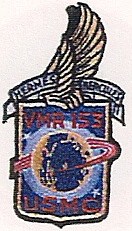VMGR-153
This article has multiple issues. Please help improve it or discuss these issues on the talk page. (Learn how and when to remove these messages)
|
| Marine Transport Squadron 153 | |
|---|---|
 VMR-153 insignia | |
| Active | 1 Mar 1942 [1] - Unknown |
| Country | |
| Branch | |
| Type | Utility/Transport |
| Role | Assault support |
| Part of | Marine Aircraft Group 25 South Pacific Combat Air Transport Command |
| Engagements | World War II * New Georgia Campaign * Battle of Vella Lavella * Bougainville Campaign * Philippines Campaign (1944-1945) * Operation Beleaguer |
Marine Transport Squadron 153 (VMR-153) was a United States Marine Corps transport squadron that provided logistical support, including cargo and personnel transport and aeromedical evacuation, to forward units during World War II. It was under the command of Marine Aircraft Group 25 and the South Pacific Combat Air Transport Command (SCAT).[2]
History
Marine Utility Squadron 153 (VMJ-153) was commissioned on 1 March 1942 at Marine Corps Air Depot Miramar, San Diego, California.[1]
VMJ-153 arrived overseas at Tontouta, New Caledonia, in March 1943, joining SCAT prior to the invasion of New Georgia. SCAT provided rapid transport of personnel and cargo, including munitions, food, replacement parts, and medical supplies, to and from forward areas. On rearward flights SCAT frequently provided aeromedical evacuation of wounded or sick personnel. These missions continued under MAG-25 and, until February 1945, Solomons Combat Air Transport Command, after the dissolution of SOPAC Combat Air Transport Command in July 1944. Like other Marine Corps utility squadrons in-theater, VMJ-153 was redesignated as a Marine Transport Squadron (VMR) in July 1944. As a component of SCAT, VMR-153 received a Navy Unit Commendation for its operations in the South Pacific from December 1942 to July 1944.[3]
In October 1945, MAG-25 moved to Tsingtao, China, where VMR-153 participated in the evacuation of liberated prisoners from the Weixian Internment Camp.[4] The squadron departed Tsingtao in January 1949 with the last elements of Marine Corps aviation to depart China.[5]
Notable former members
- John Otis Carney - navigator, who authored numerous screenplays and books.[6]
- William K. Lanman, executive officer, who became a millionaire benefactor of Yale University.
See also
References
Notes
- ^ a b Rottman 2002, pp. 441.
- ^ Armstrong, William. (2017). Marine Air Group 25 and SCAT (Images of Aviation). Arcadia. ISBN 1467127434
- ^ Armstrong, William. (2017). Marine Air Group 25 and SCAT (Images of Aviation). Arcadia. ISBN 1467127434.
- ^ Armstrong, William. (2017). Marine Air Group 25 and SCAT (Images of Aviation). Arcadia. ISBN 1467127434.
- ^ Sherrod 1952, pp. 421.
- ^ https://www.imdb.com/name/nm0138835/
Bibliography
- Armstrong, William. (2017). Marine Air Group 25 and SCAT (Images of Aviation). Arcadia. ISBN 1467127434.
- Rottman, Gordon L. (2002). U.S. Marine Corps World War II Order of Battle – Ground and Air Units in the Pacific War. Westport, Connecticut: Greenwood Press. ISBN 0313319065.
- Sherrod, Robert (1952). History of Marine Corps Aviation in World War II. Washington, D.C.: Combat Forces Press. ISBN 0-89201-048-7.
Further reading
- Capt. Robert Joseph Allen and 1st Lt. Otis Carney, The Story of SCAT: Part I and The Story of SCAT: Part II, in Air Transport magazine, December 1944 and January 1945, accessed at The DC3 Aviation Museum [1] and [2] 2 August 2006
- Capt. John M. Rentz, Marines in the Central Solomons (Ch.6, The Role of Aviation: pp. 141–145), USMC Monograph accessed at [3] 2 August 2006
- Maj. Gen. Norman J. Anderson and Col. William K. Snyder, SCAT, Marine Corps Gazette, September 1992 accessed at [4] 2 August 2006
